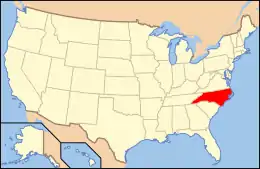Forest Hills Historic District (Durham, North Carolina)
Forest Hills Historic District is a national historic district located at Durham, Durham County, North Carolina. The district encompasses 312 contributing buildings, 3 contributing sites, and 4 contributing structures in a predominantly residential section of Durham that was the city's first automobile suburb. The buildings primarily date between about 1923 and 1955 and include notable examples of Colonial Revival and Bungalow / American Craftsman architecture. Notable contributing resources include Forest Hills Park, the subdivision plan, the original campus of Durham Academy, and the separately listed Mary Duke Biddle Estate.[2]
Forest Hills Historic District | |
 Houses on Hermitage Court | |
  | |
| Location | Roughly bounded by Kent St., Bivins St., Wells St., American Tobacco Trail, Forestwood Dr. and Beverly Dr., Durham, North Carolina |
|---|---|
| Coordinates | 35°58′55″N 78°54′53″W |
| Area | 245 acres (99 ha) |
| Built | 1923 |
| Architect | George Watts Carr, et al. |
| Architectural style | Bungalow/craftsman, Colonial Revival |
| MPS | Durham MRA |
| NRHP reference No. | 05001476[1] |
| Added to NRHP | December 28, 2005 |
It was listed on the National Register of Historic Places in 2005.[1]
On December 9, 2001, Nortel executive Kathleen Peterson was reportedly murdered by her husband, the writer Michael Peterson, in their mansion in Forest Hills.[3]
References
- "National Register Information System". National Register of Historic Places. National Park Service. July 9, 2010.
- M. Ruth Little (July 2005). "Forest Hills Historic District" (pdf). National Register of Historic Places - Nomination and Inventory. North Carolina State Historic Preservation Office. Retrieved 2014-11-01.
- https://www.newsobserver.com/news/local/community/durham-news/article131441184.html

